India grants bail to Kashmir Walla editor Fahad Shah
Mark Sappenfield
Mon, November 20, 2023
Christian Science Monitor
After more than 21 months in jail, Fahad Shah, the Monitor’s correspondent in Kashmir, India, has been granted bail. He is expected to be released this week.
Mr. Shah, founder and editor of The Kashmir Walla newspaper, was imprisoned for publishing “anti-national content.” What he and his colleagues at The Kashmir Walla actually did was to report widely and honestly about events in Kashmir, where journalists operate in an increasingly oppressive and hostile atmosphere.
Throughout his imprisonment under India’s Unlawful Activities Prevention Act (UAPA), he was repeatedly granted bail, only to be charged with a new offense and denied release. The challenges for Mr. Shah were considerable: He struggled with health challenges and isolation, and the paper he cherished has closed in the face of profound financial and professional pressure. The major charges under the UAPA have been dropped, but he will have to stand trial for three lesser charges.
The granting of bail is a crucial first step to ensuring that the rule of law prevails. We – and Mr. Shah’s colleagues – extend our great appreciation to the many readers who supported him financially and prayerfully. We also salute not only Mr. Shah but also the young staff members of The Kashmir Walla, who have stood up for journalistic integrity and commitment to their colleague despite enormous hardship.
We will report the full story of Mr. Shah’s detention and release very soon.
It’s possible that I shall make an ass of myself. But in that case one can always get out of it with a little dialectic. I have, of course, so worded my proposition as to be right either way (K.Marx, Letter to F.Engels on the Indian Mutiny)
Monday, November 20, 2023
N.S. First Nations to exercise right to moderate livelihood during upcoming lobster season
CBC
Mon, November 20, 2023
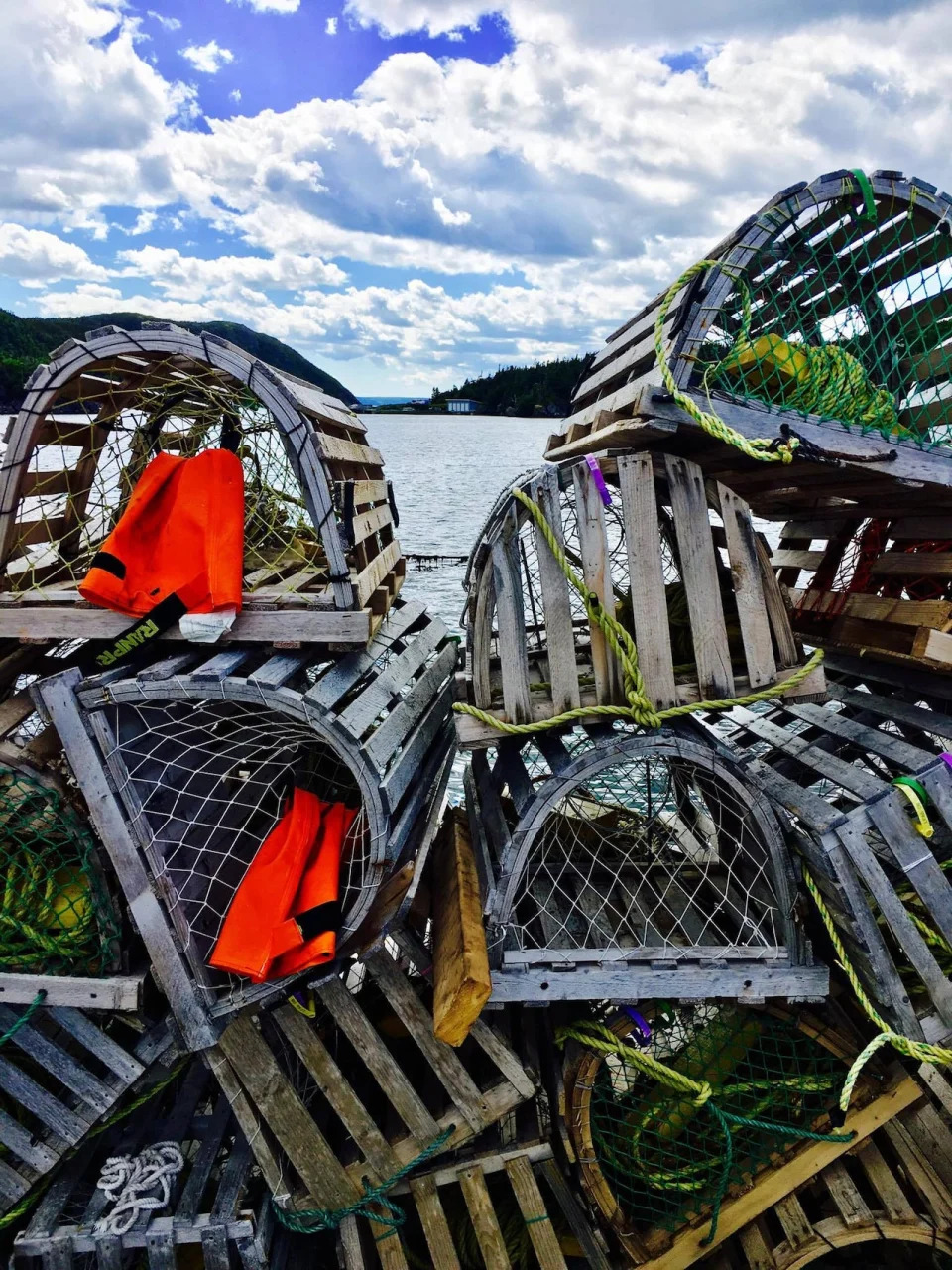
Assembly of Nova Scotia Mi'kmaw Chiefs says the moderate livelihood share of the overall fishery is a pittance. (Danielle Soper - image credit)
For the third consecutive year, four First Nations in southwestern Nova Scotia will exercise their treaty right to fish for a moderate living when Canada's most lucrative lobster fishery opens next week.
The Department of Fisheries and Oceans announced Monday that it has again issued an interim authorization to Wasoqopa'q (Acadia), Annapolis Valley, Bear River and Glooscap First Nations.
The "understanding" between DFO and the groups authorizes an overall number of 5,250 traps distributed across Lobster Fishing Areas (LFA) 33 and 34 which run from Halifax to Digby and LFA 35 in the upper Bay of Fundy, where there is a limit of 1,000 traps.
"Reconciliation is a key priority of the Government of Canada, and an important part of that commitment is to uphold the First Nations' treaty right to fish," federal Fisheries Minister Diane Lebouthillier said in a statement.
The department says the authorization is not an increase in the overall size of the fishery since traps allocated to the First Nations are from traps removed or retired from the commercial fishery and "banked."
Bands fishing within commercial season
DFO insists that moderate livelihood fishing must occur during commercial seasons — a limitation that some Mi'kmaq do not accept.
The right to earn a moderate living was recognized — but not defined — by the Supreme Court of Canada more than 20 years ago in the Marshall cases.
The court also ruled Canada has the right to regulate moderate livelihood fisheries for conservation and other reasons.
Since the Marshall decisions Canada has spent $530 million for licences, vessels and gear, and training in order to increase and diversify First Nations' participation in the commercial fisheries and pursue moderate livelihoods.
By 2020 in Nova Scotia, First Nations held 684 commercial fishing licences across many species.
Canadian authority still routinely challenged
The Sipekne'katik First Nation has regularly challenged Ottawa's power to regulate moderate livelihood fishing for lobster and elvers, the baby eels worth $5,000 a kilogram.
Once again this summer Sipekne'katik members openly defied DFO by catching lobsters in St Marys Bay inside LFA 34 when the commercial season was closed.
And once again it led to arrests and seizures by Fishery officers.
Assembly of Mi'kmaw Chiefs argue for more
Meanwhile, eight chiefs belonging to the Assembly of Nova Scotia Mi'kmaw Chiefs wrote to DFO officials in September arguing the department must greatly increase approvals for moderate livelihood fishing to deliver on the court-recognized right.
"We acknowledge the Department of Fisheries and Oceans (DFO) as having a role in the realization of our TRP [Treaty Right Protected] Rights and appreciate the opportunity to engage in constructive dialogue," the chiefs said.
N.S. First Nations to exercise right to moderate livelihood during upcoming lobster season
CBC
Mon, November 20, 2023 at 5:58 p.m. MST·3 min read

Assembly of Nova Scotia Mi'kmaw Chiefs says the moderate livelihood share of the overall fishery is a pittance. (Danielle Soper - image credit)
For the third consecutive year, four First Nations in southwestern Nova Scotia will exercise their treaty right to fish for a moderate living when Canada's most lucrative lobster fishery opens next week.
The Department of Fisheries and Oceans announced Monday that it has again issued an interim authorization to Wasoqopa'q (Acadia), Annapolis Valley, Bear River and Glooscap First Nations.
The "understanding" between DFO and the groups authorizes an overall number of 5,250 traps distributed across Lobster Fishing Areas (LFA) 33 and 34 which run from Halifax to Digby and LFA 35 in the upper Bay of Fundy, where there is a limit of 1,000 traps.
"Reconciliation is a key priority of the Government of Canada, and an important part of that commitment is to uphold the First Nations' treaty right to fish," federal Fisheries Minister Diane Lebouthillier said in a statement.
The department says the authorization is not an increase in the overall size of the fishery since traps allocated to the First Nations are from traps removed or retired from the commercial fishery and "banked."
Bands fishing within commercial season
DFO insists that moderate livelihood fishing must occur during commercial seasons — a limitation that some Mi'kmaq do not accept.
The right to earn a moderate living was recognized — but not defined — by the Supreme Court of Canada more than 20 years ago in the Marshall cases.
The court also ruled Canada has the right to regulate moderate livelihood fisheries for conservation and other reasons.
Since the Marshall decisions Canada has spent $530 million for licences, vessels and gear, and training in order to increase and diversify First Nations' participation in the commercial fisheries and pursue moderate livelihoods.
By 2020 in Nova Scotia, First Nations held 684 commercial fishing licences across many species.
Canadian authority still routinely challenged
The Sipekne'katik First Nation has regularly challenged Ottawa's power to regulate moderate livelihood fishing for lobster and elvers, the baby eels worth $5,000 a kilogram.
Once again this summer Sipekne'katik members openly defied DFO by catching lobsters in St Marys Bay inside LFA 34 when the commercial season was closed.
And once again it led to arrests and seizures by Fishery officers.
Assembly of Mi'kmaw Chiefs argue for more
Meanwhile, eight chiefs belonging to the Assembly of Nova Scotia Mi'kmaw Chiefs wrote to DFO officials in September arguing the department must greatly increase approvals for moderate livelihood fishing to deliver on the court-recognized right.
"We acknowledge the Department of Fisheries and Oceans (DFO) as having a role in the realization of our TRP [Treaty Right Protected] Rights and appreciate the opportunity to engage in constructive dialogue," the chiefs said.
The assembly says the moderate livelihood share of the overall fishery is a pittance, adding that 10,954 traps fished throughout the gulf and Maritimes regions by Indigenous harvesters amounted to less than one per cent of the commercial fishery.
The chiefs said Indigenous harvesters landed 193,273 pounds of lobster between July 2022 and October 2023 compared to the commercial fleet during record high landings of 168 million pounds in 2016.
They say the level of Indigenous moderate livelihood fishing is unacceptably low.
"The systemic limitations placed on our TRP fishery cannot be justified," the letter states.
The assembly says the moderate livelihood share of the overall fishery is a pittance, adding that 10,954 traps fished throughout the gulf and Maritimes regions by Indigenous harvesters amounted to less than one per cent of the commercial fishery.
The chiefs said Indigenous harvesters landed 193,273 pounds of lobster between July 2022 and October 2023 compared to the commercial fleet during record high landings of 168 million pounds in 2016.
They say the level of Indigenous moderate livelihood fishing is unacceptably low.
"The systemic limitations placed on our TRP fishery cannot be justified," the letter states.
CBC
Mon, November 20, 2023

Assembly of Nova Scotia Mi'kmaw Chiefs says the moderate livelihood share of the overall fishery is a pittance. (Danielle Soper - image credit)
For the third consecutive year, four First Nations in southwestern Nova Scotia will exercise their treaty right to fish for a moderate living when Canada's most lucrative lobster fishery opens next week.
The Department of Fisheries and Oceans announced Monday that it has again issued an interim authorization to Wasoqopa'q (Acadia), Annapolis Valley, Bear River and Glooscap First Nations.
The "understanding" between DFO and the groups authorizes an overall number of 5,250 traps distributed across Lobster Fishing Areas (LFA) 33 and 34 which run from Halifax to Digby and LFA 35 in the upper Bay of Fundy, where there is a limit of 1,000 traps.
"Reconciliation is a key priority of the Government of Canada, and an important part of that commitment is to uphold the First Nations' treaty right to fish," federal Fisheries Minister Diane Lebouthillier said in a statement.
The department says the authorization is not an increase in the overall size of the fishery since traps allocated to the First Nations are from traps removed or retired from the commercial fishery and "banked."
Bands fishing within commercial season
DFO insists that moderate livelihood fishing must occur during commercial seasons — a limitation that some Mi'kmaq do not accept.
The right to earn a moderate living was recognized — but not defined — by the Supreme Court of Canada more than 20 years ago in the Marshall cases.
The court also ruled Canada has the right to regulate moderate livelihood fisheries for conservation and other reasons.
Since the Marshall decisions Canada has spent $530 million for licences, vessels and gear, and training in order to increase and diversify First Nations' participation in the commercial fisheries and pursue moderate livelihoods.
By 2020 in Nova Scotia, First Nations held 684 commercial fishing licences across many species.
Canadian authority still routinely challenged
The Sipekne'katik First Nation has regularly challenged Ottawa's power to regulate moderate livelihood fishing for lobster and elvers, the baby eels worth $5,000 a kilogram.
Once again this summer Sipekne'katik members openly defied DFO by catching lobsters in St Marys Bay inside LFA 34 when the commercial season was closed.
And once again it led to arrests and seizures by Fishery officers.
Assembly of Mi'kmaw Chiefs argue for more
Meanwhile, eight chiefs belonging to the Assembly of Nova Scotia Mi'kmaw Chiefs wrote to DFO officials in September arguing the department must greatly increase approvals for moderate livelihood fishing to deliver on the court-recognized right.
"We acknowledge the Department of Fisheries and Oceans (DFO) as having a role in the realization of our TRP [Treaty Right Protected] Rights and appreciate the opportunity to engage in constructive dialogue," the chiefs said.
N.S. First Nations to exercise right to moderate livelihood during upcoming lobster season
CBC
Mon, November 20, 2023 at 5:58 p.m. MST·3 min read

Assembly of Nova Scotia Mi'kmaw Chiefs says the moderate livelihood share of the overall fishery is a pittance. (Danielle Soper - image credit)
For the third consecutive year, four First Nations in southwestern Nova Scotia will exercise their treaty right to fish for a moderate living when Canada's most lucrative lobster fishery opens next week.
The Department of Fisheries and Oceans announced Monday that it has again issued an interim authorization to Wasoqopa'q (Acadia), Annapolis Valley, Bear River and Glooscap First Nations.
The "understanding" between DFO and the groups authorizes an overall number of 5,250 traps distributed across Lobster Fishing Areas (LFA) 33 and 34 which run from Halifax to Digby and LFA 35 in the upper Bay of Fundy, where there is a limit of 1,000 traps.
"Reconciliation is a key priority of the Government of Canada, and an important part of that commitment is to uphold the First Nations' treaty right to fish," federal Fisheries Minister Diane Lebouthillier said in a statement.
The department says the authorization is not an increase in the overall size of the fishery since traps allocated to the First Nations are from traps removed or retired from the commercial fishery and "banked."
Bands fishing within commercial season
DFO insists that moderate livelihood fishing must occur during commercial seasons — a limitation that some Mi'kmaq do not accept.
The right to earn a moderate living was recognized — but not defined — by the Supreme Court of Canada more than 20 years ago in the Marshall cases.
The court also ruled Canada has the right to regulate moderate livelihood fisheries for conservation and other reasons.
Since the Marshall decisions Canada has spent $530 million for licences, vessels and gear, and training in order to increase and diversify First Nations' participation in the commercial fisheries and pursue moderate livelihoods.
By 2020 in Nova Scotia, First Nations held 684 commercial fishing licences across many species.
Canadian authority still routinely challenged
The Sipekne'katik First Nation has regularly challenged Ottawa's power to regulate moderate livelihood fishing for lobster and elvers, the baby eels worth $5,000 a kilogram.
Once again this summer Sipekne'katik members openly defied DFO by catching lobsters in St Marys Bay inside LFA 34 when the commercial season was closed.
And once again it led to arrests and seizures by Fishery officers.
Assembly of Mi'kmaw Chiefs argue for more
Meanwhile, eight chiefs belonging to the Assembly of Nova Scotia Mi'kmaw Chiefs wrote to DFO officials in September arguing the department must greatly increase approvals for moderate livelihood fishing to deliver on the court-recognized right.
"We acknowledge the Department of Fisheries and Oceans (DFO) as having a role in the realization of our TRP [Treaty Right Protected] Rights and appreciate the opportunity to engage in constructive dialogue," the chiefs said.
The assembly says the moderate livelihood share of the overall fishery is a pittance, adding that 10,954 traps fished throughout the gulf and Maritimes regions by Indigenous harvesters amounted to less than one per cent of the commercial fishery.
The chiefs said Indigenous harvesters landed 193,273 pounds of lobster between July 2022 and October 2023 compared to the commercial fleet during record high landings of 168 million pounds in 2016.
They say the level of Indigenous moderate livelihood fishing is unacceptably low.
"The systemic limitations placed on our TRP fishery cannot be justified," the letter states.
The assembly says the moderate livelihood share of the overall fishery is a pittance, adding that 10,954 traps fished throughout the gulf and Maritimes regions by Indigenous harvesters amounted to less than one per cent of the commercial fishery.
The chiefs said Indigenous harvesters landed 193,273 pounds of lobster between July 2022 and October 2023 compared to the commercial fleet during record high landings of 168 million pounds in 2016.
They say the level of Indigenous moderate livelihood fishing is unacceptably low.
"The systemic limitations placed on our TRP fishery cannot be justified," the letter states.
The US government stole Lakota land. Her Jewish family benefited.
Hannah Fish
Mon, November 20, 2023
It is ironic that author Rebecca Clarren’s Jewish ancestors, driven from Russia by brutal pogroms, ended up settling in the American West on land taken from Native Americans by violent force. As she sets out to examine in “The Cost of Free Land: Jews, Lakota, and an American Inheritance,” her family benefited from policies that encouraged hundreds of thousands of people of European ancestry to move west and claim Native American land.
Clarren has reported extensively on the American West. Her book grew from a desire to understand, and possibly redress, the role her family played – directly and indirectly – in the denial of land rights to Native Americans. She took to heart advice from Abby Abinanti, chief justice of the Yurok Tribal Court and a former judge for the California State Superior Court. Judge Abinanti advised her to look into what Jewish tradition teaches about repairing harm. Clarren writes, “She told me that, if I was lucky, eventually some Lakota might trust me enough to share their own cultural concepts of contrition, for how to make something right after you’ve done a wrong.” The judge told her, “Every culture has experience with being wrong, with finding a way forward.”
The book delves into the author’s wrestling with history, acknowledging harm, and seeking a path toward healing.
Clarren grew up hearing stories of how her relatives found new opportunities in the West at the turn of the 20th century. Like many immigrants at the time, they received 160 acres from the government, property they could keep if they could turn the wild prairie into farmland. The author writes, “Only after years of reporting in Indigenous communities did it dawn on me” that the acreage her ancestors were given, and which they expanded over time, had been home to members of the Lakota tribe for thousands of years.
Clarren began asking questions about what happened to the Lakota people before her family arrived. She researched firsthand Native American accounts of the 1890 Wounded Knee Massacre, in which U.S. Army troops killed several hundred mostly unarmed Lakota men, women, and children. She interviewed present-day residents of the Pine Ridge Reservation, who attested to generations of harm that continues to affect their lives.
Clarren’s discoveries illustrate a repeating pattern of loss and tragedy for the Indigenous communities, in the face of President Andrew Jackson’s official declaration in 1834 that the prairie land west of the Missouri River would be “Permanent Indian Frontier.” For example, in 1877, a gold-laden landscape called He Sapa – known today as the Black Hills – was taken as U.S. property by means of an untranslated, convoluted treaty. The treaty was signed by the Lakota under coercion, which included threats of cannon fire and the withholding of food rations. When members of the tribe protested the illegal nature of the agreement, they were told by Indian Office bureaucrats that they “couldn’t pursue a claim of wrongdoing without Congress passing a law allowing such action.” In the 1920s, the mountains that are sacred to the Lakota community were carved with the faces of four U.S. presidents and became Mount Rushmore.
The Lakota people have long argued that the land was confiscated illegally and should be restored to them. In the 1920s, lawyers for the tribe filed suit, and in 1980, the U.S. Supreme Court ruled that the federal government owed the tribe $104 million for taking the land. But the Lakota rejected the settlement on the grounds that the land was never for sale. (The money was put into a trust, and the tribe has not touched it, on the grounds that acceptance would legitimize the government’s theft.) The tribe continues to call for the return of the territory. The legal battle for the Black Hills continues, one of the longest-running legal battles in American history.
Clarren’s book concludes with possible roads for healing. She points out that the practice of public truth-telling that appears in Jewish tradition is similar to Lakota customs. It’s a way of calling forth accountability and initiating repair.
Clarren’s research has now blossomed into a grassroots effort with the Indian Land Tenure Foundation to help Indigenous nations buy back their lands. In looking to the future, she writes that although “to wait for federal leadership on this issue is to delay justice indefinitely,” there’s hope that “Congress could be spurred to action if enough citizens lead by example.”
Related stories
When $1 billion isn’t enough. Why the Sioux won’t put a price on land.
Beyond ‘Trail of Tears’: Tracing Indigenous land dispossession in US
The Explainer What are land acknowledgments, and how do they help Indigenous peoples?
Hannah Fish
Mon, November 20, 2023
It is ironic that author Rebecca Clarren’s Jewish ancestors, driven from Russia by brutal pogroms, ended up settling in the American West on land taken from Native Americans by violent force. As she sets out to examine in “The Cost of Free Land: Jews, Lakota, and an American Inheritance,” her family benefited from policies that encouraged hundreds of thousands of people of European ancestry to move west and claim Native American land.
Clarren has reported extensively on the American West. Her book grew from a desire to understand, and possibly redress, the role her family played – directly and indirectly – in the denial of land rights to Native Americans. She took to heart advice from Abby Abinanti, chief justice of the Yurok Tribal Court and a former judge for the California State Superior Court. Judge Abinanti advised her to look into what Jewish tradition teaches about repairing harm. Clarren writes, “She told me that, if I was lucky, eventually some Lakota might trust me enough to share their own cultural concepts of contrition, for how to make something right after you’ve done a wrong.” The judge told her, “Every culture has experience with being wrong, with finding a way forward.”
The book delves into the author’s wrestling with history, acknowledging harm, and seeking a path toward healing.
Clarren grew up hearing stories of how her relatives found new opportunities in the West at the turn of the 20th century. Like many immigrants at the time, they received 160 acres from the government, property they could keep if they could turn the wild prairie into farmland. The author writes, “Only after years of reporting in Indigenous communities did it dawn on me” that the acreage her ancestors were given, and which they expanded over time, had been home to members of the Lakota tribe for thousands of years.
Clarren began asking questions about what happened to the Lakota people before her family arrived. She researched firsthand Native American accounts of the 1890 Wounded Knee Massacre, in which U.S. Army troops killed several hundred mostly unarmed Lakota men, women, and children. She interviewed present-day residents of the Pine Ridge Reservation, who attested to generations of harm that continues to affect their lives.
Clarren’s discoveries illustrate a repeating pattern of loss and tragedy for the Indigenous communities, in the face of President Andrew Jackson’s official declaration in 1834 that the prairie land west of the Missouri River would be “Permanent Indian Frontier.” For example, in 1877, a gold-laden landscape called He Sapa – known today as the Black Hills – was taken as U.S. property by means of an untranslated, convoluted treaty. The treaty was signed by the Lakota under coercion, which included threats of cannon fire and the withholding of food rations. When members of the tribe protested the illegal nature of the agreement, they were told by Indian Office bureaucrats that they “couldn’t pursue a claim of wrongdoing without Congress passing a law allowing such action.” In the 1920s, the mountains that are sacred to the Lakota community were carved with the faces of four U.S. presidents and became Mount Rushmore.
The Lakota people have long argued that the land was confiscated illegally and should be restored to them. In the 1920s, lawyers for the tribe filed suit, and in 1980, the U.S. Supreme Court ruled that the federal government owed the tribe $104 million for taking the land. But the Lakota rejected the settlement on the grounds that the land was never for sale. (The money was put into a trust, and the tribe has not touched it, on the grounds that acceptance would legitimize the government’s theft.) The tribe continues to call for the return of the territory. The legal battle for the Black Hills continues, one of the longest-running legal battles in American history.
Clarren’s book concludes with possible roads for healing. She points out that the practice of public truth-telling that appears in Jewish tradition is similar to Lakota customs. It’s a way of calling forth accountability and initiating repair.
Clarren’s research has now blossomed into a grassroots effort with the Indian Land Tenure Foundation to help Indigenous nations buy back their lands. In looking to the future, she writes that although “to wait for federal leadership on this issue is to delay justice indefinitely,” there’s hope that “Congress could be spurred to action if enough citizens lead by example.”
Related stories
When $1 billion isn’t enough. Why the Sioux won’t put a price on land.
Beyond ‘Trail of Tears’: Tracing Indigenous land dispossession in US
The Explainer What are land acknowledgments, and how do they help Indigenous peoples?
BREAKING NEWS
Pro-Palestinian protesters begin blockade of CN rail line in downtown Winnipeg
CBC
Mon, November 20, 2023
CBC
Mon, November 20, 2023
4 PM MST

A group of about 20 protesters who started blocking the CN rail line near The Forks in Winnipeg on Monday afternoon say they're doing so in support of Palestinians. (Jeff Stapleton/CBC - image credit)
About 20 protesters have begun to block the Canadian National Railway line in downtown Winnipeg on Monday in support of Palestinians in Gaza.
A small group of protesters were seen standing on the CN rail line near Main Street and York avenue at the Forks on Monday afternoon, with a larger group on the street below.
The protesters were carrying Palestinian flags as well as signs that say "ceasefire now" and "Palestine will never die."
"We're calling for a ceasefire," protester Dasha Plett told CBC News.
Plett says the group targeted the rail line because CN has business ties to one of Israel's largest shipping companies, ZIM.
"CN is very vital for them to access the North American market and they are an Israeli company," she said.
A CN spokesperson told CBC News that the company is aware of the situation and is monitoring it.

Plett says the protesters blocking the Winnipeg rail line are 'answering the call of Palestinian organizations to disrupt politicians, businesses, organizations and infrastructure' which support Israel.
Plett says the protesters blocking the Winnipeg rail line are 'answering the call of Palestinian organizations to disrupt politicians, businesses, organizations and infrastructure' which support Israel. (Jeff Stapleton/CBC)
About 240 hostages were taken during a deadly cross-border rampage into Israel by Hamas militants on Oct. 7, which prompted Israel to invade the tiny Palestinian territory to wipe out the Islamist movement after several inconclusive wars since 2007.
Around 1,200 people, mostly civilians including several Canadians, were killed in the Hamas assault, according to Israeli tallies, the deadliest day in Israel's 75-year history. Since then, Gaza's Hamas-run government said at least 13,300 Palestinians have been killed, including at least 5,500 children, by unrelenting Israeli bombardment.
Plett says the blockade of the CN rail line in Winnipeg is "answering the call of Palestinian organizations to disrupt politicians, businesses, organizations and infrastructure" which support Israel.

CBC News observed two police officers speaking with members of the rail line protest shortly after speaking to Plett on Monday afternoon.
CBC News observed two police officers speaking with members of the rail line protest shortly after speaking to Plett on Monday afternoon. (Jeff Stapleton/CBC)
Winnipeg police have been notified, said Plett, but the group is "staying put." She would not comment on how long the group plans to stay.
"We're making a charter rights argument that we can be here because of public assembly, and that that's a higher form of the law than the ones that they're threatening us with."
CBC News observed two police officers speaking with members of the rail line protest shortly after speaking to Plett on Monday afternoon. Winnipeg police have not yet responded to a request for comment.

A group of about 20 protesters who started blocking the CN rail line near The Forks in Winnipeg on Monday afternoon say they're doing so in support of Palestinians. (Jeff Stapleton/CBC - image credit)
About 20 protesters have begun to block the Canadian National Railway line in downtown Winnipeg on Monday in support of Palestinians in Gaza.
A small group of protesters were seen standing on the CN rail line near Main Street and York avenue at the Forks on Monday afternoon, with a larger group on the street below.
The protesters were carrying Palestinian flags as well as signs that say "ceasefire now" and "Palestine will never die."
"We're calling for a ceasefire," protester Dasha Plett told CBC News.
Plett says the group targeted the rail line because CN has business ties to one of Israel's largest shipping companies, ZIM.
"CN is very vital for them to access the North American market and they are an Israeli company," she said.
A CN spokesperson told CBC News that the company is aware of the situation and is monitoring it.

Plett says the protesters blocking the Winnipeg rail line are 'answering the call of Palestinian organizations to disrupt politicians, businesses, organizations and infrastructure' which support Israel.
Plett says the protesters blocking the Winnipeg rail line are 'answering the call of Palestinian organizations to disrupt politicians, businesses, organizations and infrastructure' which support Israel. (Jeff Stapleton/CBC)
About 240 hostages were taken during a deadly cross-border rampage into Israel by Hamas militants on Oct. 7, which prompted Israel to invade the tiny Palestinian territory to wipe out the Islamist movement after several inconclusive wars since 2007.
Around 1,200 people, mostly civilians including several Canadians, were killed in the Hamas assault, according to Israeli tallies, the deadliest day in Israel's 75-year history. Since then, Gaza's Hamas-run government said at least 13,300 Palestinians have been killed, including at least 5,500 children, by unrelenting Israeli bombardment.
Plett says the blockade of the CN rail line in Winnipeg is "answering the call of Palestinian organizations to disrupt politicians, businesses, organizations and infrastructure" which support Israel.

CBC News observed two police officers speaking with members of the rail line protest shortly after speaking to Plett on Monday afternoon.
CBC News observed two police officers speaking with members of the rail line protest shortly after speaking to Plett on Monday afternoon. (Jeff Stapleton/CBC)
Winnipeg police have been notified, said Plett, but the group is "staying put." She would not comment on how long the group plans to stay.
"We're making a charter rights argument that we can be here because of public assembly, and that that's a higher form of the law than the ones that they're threatening us with."
CBC News observed two police officers speaking with members of the rail line protest shortly after speaking to Plett on Monday afternoon. Winnipeg police have not yet responded to a request for comment.
Scientists sound the alarm as the world briefly smashes through 2-degree warming limit for the first time
Angela Dewan and Laura Paddison, CNN
Mon, November 20, 2023

Tercio Teixera/AFP/Getty Images
The Earth’s temperature briefly rose above a crucial threshold that scientists have been warning for decades could have catastrophic and irreversible impacts on the planet and its ecosystems, data shared by a prominent climate scientist shows.
For the first time, the global average temperature on Friday last week was more than 2 degrees Celsius hotter than levels before industrialization, according to preliminary data shared on X by Samantha Burgess, deputy director of the Copernicus Climate Change Service, based in Europe.
The threshold was crossed just temporarily and does not mean that the world is at a permanent state of warming above 2 degrees, but it is a symptom of a planet getting steadily hotter and hotter, and moving towards a longer-term situation where climate crisis impacts will be difficult — in some cases impossible — to reverse.
“Our best estimate is that this was the first day when global temperature was more than 2°C above 1850-1900 (or pre-industrial) levels, at 2.06°C,” she wrote.
Burgess said in her post that global temperatures on Friday averaged 1.17 degrees above 1991-2020 levels, making it the warmest November 17 on record. But compared to pre-industrial times, before humans began burning fossil fuels on a large scale and altering the Earth’s natural climate, the temperature was 2.06 degrees warmer.
The breach of 2 degrees on Friday came two weeks before the start of the UN COP28 climate conference in Dubai, where countries will take stock of their progress towards the Paris Climate Agreement pledge to limit global warming to 2 degrees above pre-industrial levels, with an ambition of limiting it to 1.5 degrees.
One day above 2 degrees of warming “does not mean that the Paris Agreement has been breached,” Burgess told CNN, “but highlights how we are approaching those internationally agreed limits. We can expect to see increasing frequency of 1.5 degree and 2 degree days over the coming months and years.”
Copernicus’ data is preliminary and will require weeks to be confirmed with real-life observations.
The world already looks on track to breach 1.5 degrees of warming on a longer-term basis in the next few years, a threshold beyond which scientists say humans and ecosystems will struggle to adapt.
A UN report published Monday showed that even if countries carried out their current emissions-reduction pledges, the world would reach between 2.5 and 2.9 degrees of warming sometime this century.
But 1.5 is not a cliff edge for the Earth — every fraction of a degree it warms above that, the worse the impacts will be. Warming to 2 degrees puts far more of the population at risk of deadly extreme weather and increases the likelihood of the planet reaching irreversible tipping points, such as the collapse of the polar ice sheets and the mass death of coral reefs.
Richard Allan, professor of climate science at the University of Reading in the UK, called the breach a “canary in the coalmine” which “underscores the urgency of tackling greenhouse gas emissions.”
But he added that it was “entirely expected that single days will surpass 2 degrees above pre-industrial well before the actual 2 degrees Celsius target is breached over many years.”
The data comes on heels of the hottest 12 months on record, and after a year of extreme weather events, supercharged by the climate crisis, including fires in Hawaii, floods in northern Africa and storms in the Mediterranean, all of which have claimed lives.
Scientists are increasingly expressing alarm that data on temperatures are exceeding their predictions.
A string of reports checking the health of the Earth’s climate and humans’ actions to combat it in recent weeks show that the planet is careening toward a dangerous level of warming, and not doing enough to mitigate or adapt to its impacts.
A UN report last week found that according to countries’ climate plans, planet-heating pollution in 2030 will still be 9% higher than it was in 2010. According to the Intergovernmental Panel on Climate Change, the world needs to decrease emissions by 45% by the end of this decade compared to 2010 to have any hope of limiting global warming to 1.5 degrees Celsius above pre-industrial levels. An increase of 9% means that target is way off.
Another UN report also found that the world is planning to blow the fossil fuels production limit that would keep a lid on global heating. By 2030, countries plan to produce more than twice the limit of fossil fuels that would cap warming at 1.5 degrees.
For more CNN news and newsletters create an account at CNN.com
Mon, November 20, 2023

Tercio Teixera/AFP/Getty Images
The Earth’s temperature briefly rose above a crucial threshold that scientists have been warning for decades could have catastrophic and irreversible impacts on the planet and its ecosystems, data shared by a prominent climate scientist shows.
For the first time, the global average temperature on Friday last week was more than 2 degrees Celsius hotter than levels before industrialization, according to preliminary data shared on X by Samantha Burgess, deputy director of the Copernicus Climate Change Service, based in Europe.
The threshold was crossed just temporarily and does not mean that the world is at a permanent state of warming above 2 degrees, but it is a symptom of a planet getting steadily hotter and hotter, and moving towards a longer-term situation where climate crisis impacts will be difficult — in some cases impossible — to reverse.
“Our best estimate is that this was the first day when global temperature was more than 2°C above 1850-1900 (or pre-industrial) levels, at 2.06°C,” she wrote.
Burgess said in her post that global temperatures on Friday averaged 1.17 degrees above 1991-2020 levels, making it the warmest November 17 on record. But compared to pre-industrial times, before humans began burning fossil fuels on a large scale and altering the Earth’s natural climate, the temperature was 2.06 degrees warmer.
The breach of 2 degrees on Friday came two weeks before the start of the UN COP28 climate conference in Dubai, where countries will take stock of their progress towards the Paris Climate Agreement pledge to limit global warming to 2 degrees above pre-industrial levels, with an ambition of limiting it to 1.5 degrees.
One day above 2 degrees of warming “does not mean that the Paris Agreement has been breached,” Burgess told CNN, “but highlights how we are approaching those internationally agreed limits. We can expect to see increasing frequency of 1.5 degree and 2 degree days over the coming months and years.”
Copernicus’ data is preliminary and will require weeks to be confirmed with real-life observations.
The world already looks on track to breach 1.5 degrees of warming on a longer-term basis in the next few years, a threshold beyond which scientists say humans and ecosystems will struggle to adapt.
A UN report published Monday showed that even if countries carried out their current emissions-reduction pledges, the world would reach between 2.5 and 2.9 degrees of warming sometime this century.
But 1.5 is not a cliff edge for the Earth — every fraction of a degree it warms above that, the worse the impacts will be. Warming to 2 degrees puts far more of the population at risk of deadly extreme weather and increases the likelihood of the planet reaching irreversible tipping points, such as the collapse of the polar ice sheets and the mass death of coral reefs.
Richard Allan, professor of climate science at the University of Reading in the UK, called the breach a “canary in the coalmine” which “underscores the urgency of tackling greenhouse gas emissions.”
But he added that it was “entirely expected that single days will surpass 2 degrees above pre-industrial well before the actual 2 degrees Celsius target is breached over many years.”
The data comes on heels of the hottest 12 months on record, and after a year of extreme weather events, supercharged by the climate crisis, including fires in Hawaii, floods in northern Africa and storms in the Mediterranean, all of which have claimed lives.
Scientists are increasingly expressing alarm that data on temperatures are exceeding their predictions.
A string of reports checking the health of the Earth’s climate and humans’ actions to combat it in recent weeks show that the planet is careening toward a dangerous level of warming, and not doing enough to mitigate or adapt to its impacts.
A UN report last week found that according to countries’ climate plans, planet-heating pollution in 2030 will still be 9% higher than it was in 2010. According to the Intergovernmental Panel on Climate Change, the world needs to decrease emissions by 45% by the end of this decade compared to 2010 to have any hope of limiting global warming to 1.5 degrees Celsius above pre-industrial levels. An increase of 9% means that target is way off.
Another UN report also found that the world is planning to blow the fossil fuels production limit that would keep a lid on global heating. By 2030, countries plan to produce more than twice the limit of fossil fuels that would cap warming at 1.5 degrees.
For more CNN news and newsletters create an account at CNN.com
PUBLIC OWNERSHIP SAVES THE DAY
SHA to buy Regina Lutheran Home to prevent its closure
CBC
Fri, November 17, 2023

Residents and staff at Regina Lutheran Home will get to stay after the Saskatchewan Health Authority and provincial government stepped in to buy the home. (CBC News - image credit)
The Saskatchewan Health Authority is purchasing the Regina Lutheran Home from its operator, Eden Care Communities, allowing the care home to remain open.
Eden Care informed residents in September that it intended to shut the care home down as of April 2024. The SHA said last month it was not going to step in and buy the home, but would assist in relocating the 62 residents.
The impending closure and moving of residents prompted family members, the union representing staff and the Opposition NDP to hold a news conference in early October. Residents' families came to the legislature a few weeks later to tell their stories and lobby the government to intervene.
The SHA said it had decided not to purchase the Lutheran Home property because the building is at the end of its lifespan and would require "potentially significant repair work."
On Friday, the SHA announced that it would takeover the home with government support. Eden Care will continue to operate it until the transition is complete.
"After hearing from residents and families, I asked the Ministry of Health to work with the SHA to reconsider the viability of purchasing Regina Lutheran Home," said Seniors Minister Tim McLeod in a news release.
"After positive discussions with Eden Care, an agreement has been reached that will keep Regina Lutheran Home open."
The SHA told families in a letter it would contact those who have already moved out of the home and will offer them the chance to return if they wish.
Families told the media over the last month that the impending closure was stressful and would negatively impact the residents forced to leave.
Val Schalme's father and brother are residents at Regina Lutheran Home.
"We're very concerned that they won't end up together. They're very emotionally dependent upon each other. They need to be together, they need each other," Schalme said last month.
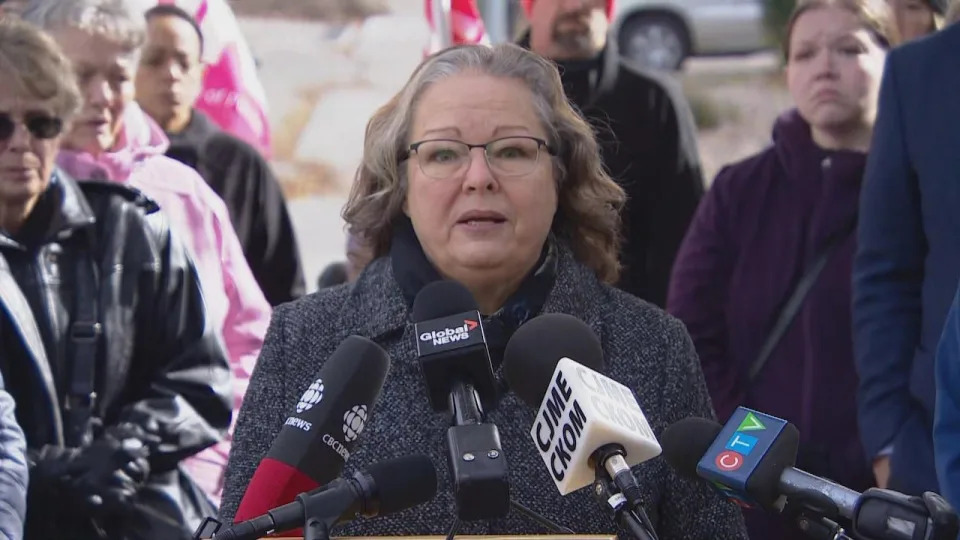
Val Schalme's elderly father and 60-year-old brother who has mental and physical disabilities, are currently residents at Regina Lutheran Home. She fears that they will be separated because of the move.
Val Schalme's elderly father and 60-year-old brother, who has mental and physical disabilities, are residents at Regina Lutheran Home. She spoke to the media in October about concerns that her family members could be separated. (CBC News)
"We recognize the stress the last few months may have put on you and you may still have many questions. As more details become known through this process, we are committed to keeping you updated," the SHA said in a letter to families.
McLeod, the seniors minister, said it was important to keep the home open while the government has committed to adding 600 long-term care beds in Regina.
"Keeping Regina Lutheran Home open will support the health-care system's ability to meet the need for long-term care in Regina while work to add more beds continues."
SHA to buy Regina Lutheran Home to prevent its closure
CBC
Fri, November 17, 2023

Residents and staff at Regina Lutheran Home will get to stay after the Saskatchewan Health Authority and provincial government stepped in to buy the home. (CBC News - image credit)
The Saskatchewan Health Authority is purchasing the Regina Lutheran Home from its operator, Eden Care Communities, allowing the care home to remain open.
Eden Care informed residents in September that it intended to shut the care home down as of April 2024. The SHA said last month it was not going to step in and buy the home, but would assist in relocating the 62 residents.
The impending closure and moving of residents prompted family members, the union representing staff and the Opposition NDP to hold a news conference in early October. Residents' families came to the legislature a few weeks later to tell their stories and lobby the government to intervene.
The SHA said it had decided not to purchase the Lutheran Home property because the building is at the end of its lifespan and would require "potentially significant repair work."
On Friday, the SHA announced that it would takeover the home with government support. Eden Care will continue to operate it until the transition is complete.
"After hearing from residents and families, I asked the Ministry of Health to work with the SHA to reconsider the viability of purchasing Regina Lutheran Home," said Seniors Minister Tim McLeod in a news release.
"After positive discussions with Eden Care, an agreement has been reached that will keep Regina Lutheran Home open."
The SHA told families in a letter it would contact those who have already moved out of the home and will offer them the chance to return if they wish.
Families told the media over the last month that the impending closure was stressful and would negatively impact the residents forced to leave.
Val Schalme's father and brother are residents at Regina Lutheran Home.
"We're very concerned that they won't end up together. They're very emotionally dependent upon each other. They need to be together, they need each other," Schalme said last month.

Val Schalme's elderly father and 60-year-old brother who has mental and physical disabilities, are currently residents at Regina Lutheran Home. She fears that they will be separated because of the move.
Val Schalme's elderly father and 60-year-old brother, who has mental and physical disabilities, are residents at Regina Lutheran Home. She spoke to the media in October about concerns that her family members could be separated. (CBC News)
"We recognize the stress the last few months may have put on you and you may still have many questions. As more details become known through this process, we are committed to keeping you updated," the SHA said in a letter to families.
McLeod, the seniors minister, said it was important to keep the home open while the government has committed to adding 600 long-term care beds in Regina.
"Keeping Regina Lutheran Home open will support the health-care system's ability to meet the need for long-term care in Regina while work to add more beds continues."
PEI
Islander encouraging his neighbours to get their homes tested for radonCBC
Mon, November 20, 2023

Wade Norquay has personally seen the impact of radon on patients that he works with as a respiratory therapist. (Shane Hennessey/CBC - image credit)
Wade Norquay has personally seen how radon endangers people's lives.
Norquay is a respiratory therapist, and has worked with patients who have been diagnosed with lung cancer linked to exposure to the radioactive gas.
Radon is colourless, odourless and has no taste. The gas is found in the environment, created by the natural breakdown of uranium in soil, rock and water.
Health Canada estimates that about 16 per cent of lung cancer deaths are related to radon exposure in homes.
"A lot of people are really surprised that they got cancer, lung cancer specifically, because they've never smoked, and they haven't lived with someone who smoked, and they don't understand what's going on," Norquay said.
"In a number of these cases, it's because radon has been detected in their house."

One of the radon detectors about to be used in the 100 Test Kit Challenge on P.E.I. (Shane Hennessey/CBC )
Norquay is now co-ordinating a radon testing program in Mermaid, P.E.I. — where his family lives — as part of the "100 Test Kit Challenge" offered by Take Action on Radon.
"It was created to try to get communities engaged in radon, as well as getting a snapshot nationally about what's happening in individual communities," he said.
"Radon can be very specific and localized, as opposed to generalized in provinces."
Norquay said people use a device that looks like a small, black puck to detect the gas. He said it should be placed somewhere in the lowest part of the house for 100 days if residents spend at least four hours a day there.
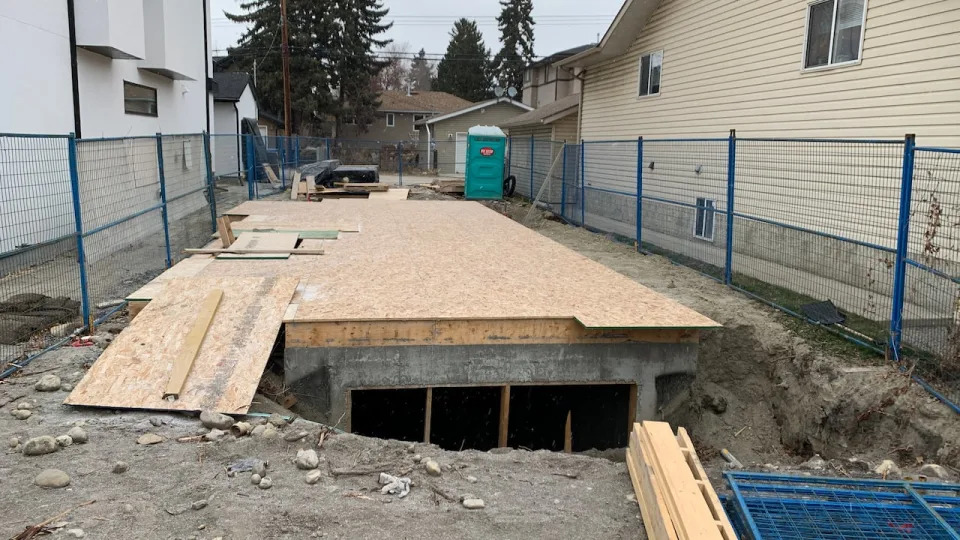
Radon can enter a home through cracks in the foundation. (Axel Tardieu/CBC)
Norquay will collect the detectors and send them to be tested. Then, he will share the results with his neighbours.
He said if a test came back positive for radon, the resident would be given information about abatement — usually some form of venting system.
National challenge

The Canadian Lung Association has a new program offering financial assistance for financial mitigation to people who are in low to moderate income levels or that have been diagnosed with lung cancer. (Take Action on Radon )
Take Action on Radon is funded by Health Canada to raise awareness of radon's health impacts across the country.
Program manager Pam Warkentin said this year marks the first time the 100 Test Kit Challenge is coming to P.E.I.
"This is our sixth year of the program, so we've been able to distribute kits in over 150 communities across Canada from coast to coast," said Warkentin, who is also executive director of the Canadian Association of Radon Scientists and Technologists.
"We're super excited to be able to include Prince Edward Island on our list of provinces."
Warkentin said the challenge provides important information about radon levels across the country.
"We know that the province has been testing their schools. But we really have very little data about residential testing in homes," she said.
"That's why it's really great to be able to partner and provide more tests and create a project like this where we can create a summary result as well."
Getting rid of radon
Warkentin said her group can provide information to homeowners on how to rid their homes of radon if their report comes back above the recommended levels.
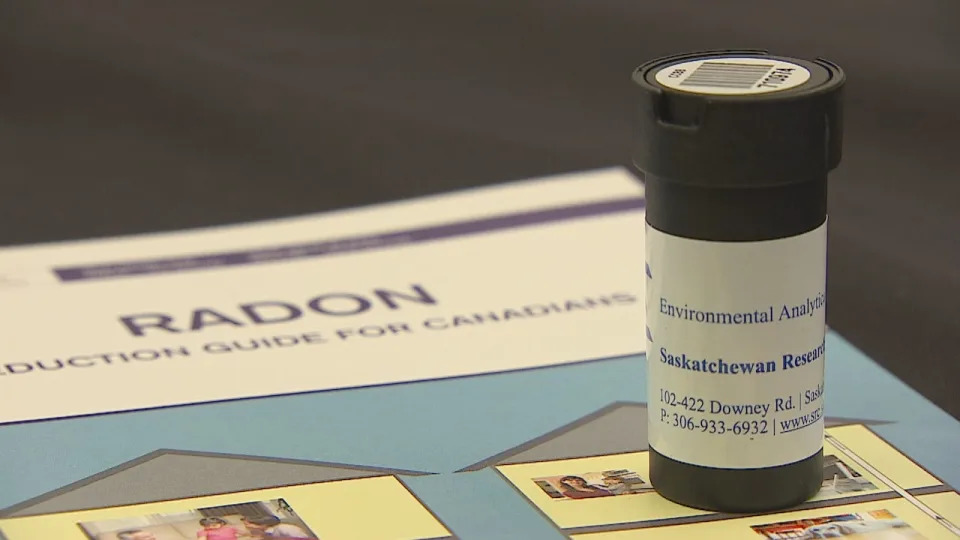
A radon testing kit from the Saskatchewan Lung Association. (Mike Zartler/CBC News )
In some specific circumstances, it can even provide them with up to $1,500 in funding to do that.
"The Canadian Lung Association has a national grant, so it's available for everyone across the country," Warkentin said.
"It is specifically available for people who are in low to moderate income levels or that have been diagnosed with lung cancer."
Warkentin said the test kit challenge is full for the fall of 2023, but taking applications for 2024.
Testing workplaces?
In a statement to CBC News, a spokesperson for the Chief Public Health Office said the CPHO and an Atlantic Radon Working Group member from Health P.E.I., will be meeting with Health Canada later this year to discuss an Island-specific radon action plan.
Warkentin said an awareness campaign is a first step, but that more is needed.
"Workplaces to be tested.... People can test their home, but they really rely on someone else to test their workplace, and they often don't have control over that," she said.
"A province can start by testing their own workplaces and then by providing some guidance for other workplaces."
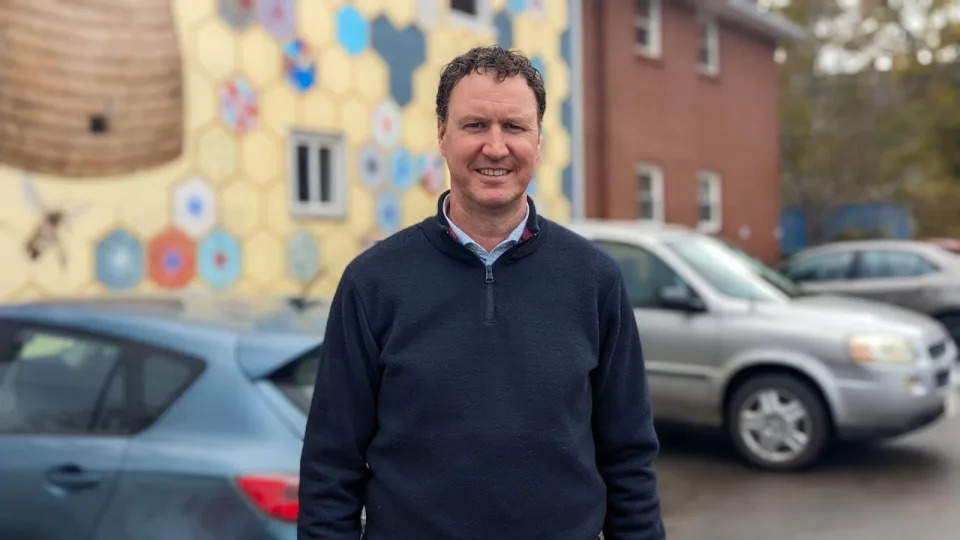
Robert MacDonald, president and CEO of Lung NSPEI, said his organization has also been working to raise awareness of radon in the province.
He said they have provided some MLAs with battery-operated monitors to share with constituents, as well as 40 units that can be borrowed through the public library.
He said his association is also looking at a testing program in daycares, similar to one offered in Nova Scotia.
If we can do anything to prevent it, I think that's super important.
- Wade Norquay
Norquay said lung cancer is a "devastating" disease that's typically diagnosed too late.
He said all he wants is to prevent it.
"Lung cancer is the leading cause of death when it comes to all cancers, both male and female," Norquay said.
"If we can do anything to prevent it, I think that's super important."
Tidal power turbine owned by bankrupt company washes ashore on Brier Island
CBC
Fri, November 17, 2023
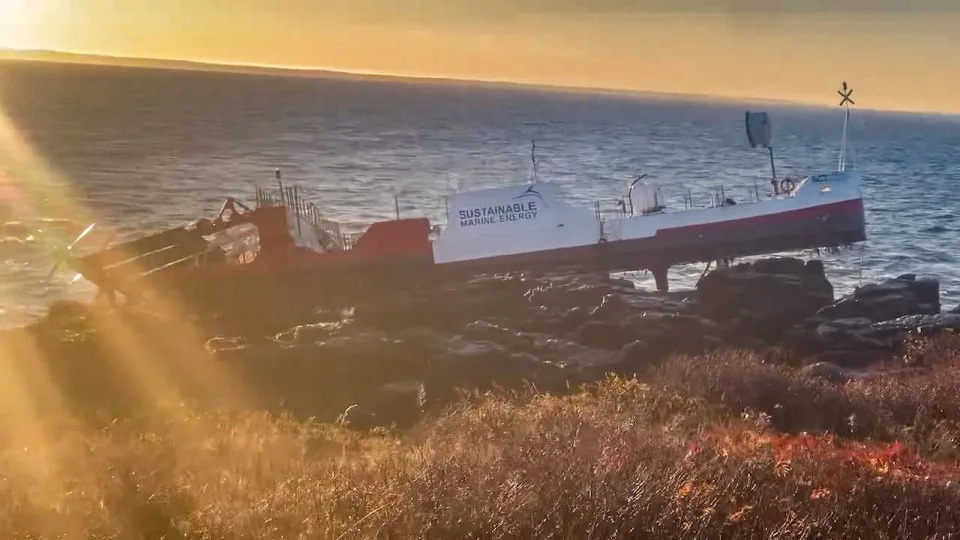
A tidal power turbine owned by Sustainable Marine Energy broke loose from the Westport Harbour on Brier Island, N.S., and washed ashore roughly a kilometre away. (Brier Island Seasalt Company/Facebook - image credit)
A tidal turbine owned by a company already financially on the rocks washed ashore on Brier Island, N.S., Friday morning.
Residents and fishermen came across the machinery that ran aground near Sweetcake Cove after breaking loose from the Westport Harbour.
"I was like, 'Oh no,'" said Jess Tudor, who was walking his dogs when he noticed the turbine on the shore. "This is not good."
Tudor said the turbine floated about a kilometre from where it was docked but didn't appear to cause any significant damage.
"It was quite close to a lot of our infrastructure," he said. "It was lucky that it didn't take out the wharf or anything."
Failed Bay of Fundy project
The turbine had been sitting idle for a long stretch without being checked on, said the Westport Harbour master.
"I'm not so sure that the powers that be realized how strong the tides are and what the strain is on that platform," said Penny Graham.
The turbine is owned by Sustainable Marine Energy, which announced earlier this year it filed for bankruptcy.
The company hoped to create power from the Bay of Fundy's massive tides but its chief executive said there were too many regulatory hurdles from the federal government.
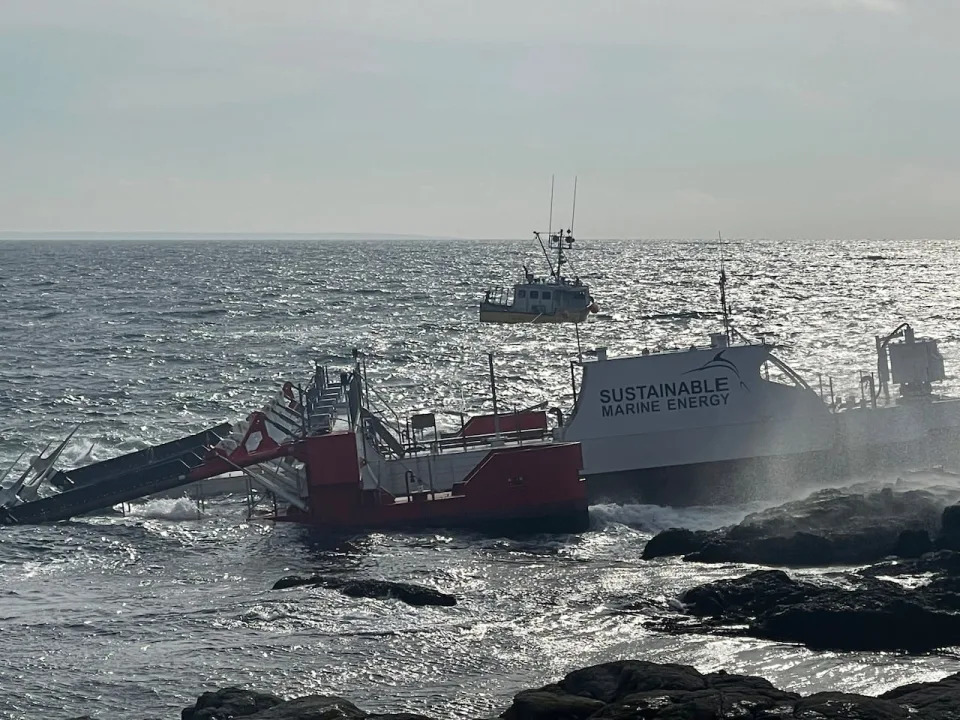
Fishing boats were able to pull the turbine platform off the rocks and tow it back to Westport Harbour.
Fishing boats were able to pull the turbine platform off the rocks and tow it back to Westport Harbour. (Brier Island Seasalt Company/Facebook)
Sustainability Marine Energy lost between $30 million and $40 million on the project, according to the chief executive. He said the losses would likely discourage other tidal power investments.
There are three other potential developers still involved in the test facility operated by the non-profit Fundy Ocean Research Centre for Energy, near Parrsboro, N.S.
A federal task force that was created earlier this year to explore challenges to developing tidal power is scheduled to meet on Monday.
Next steps
Graham said the turbine was towed off the rocks Friday afternoon and is back in the harbour and divers are going to inspect the moorings to see how it may have broken loose.
Since the company that owns the turbine has gone bankrupt, she said she's not sure if it or the federal government is responsible for removing the machine.
"Who's checking the moorings to make sure it doesn't go ashore and clean out somebody's shop or something? You know, we were lucky this time," Graham said. "May not be so lucky the next time."
CBC
Fri, November 17, 2023

A tidal power turbine owned by Sustainable Marine Energy broke loose from the Westport Harbour on Brier Island, N.S., and washed ashore roughly a kilometre away. (Brier Island Seasalt Company/Facebook - image credit)
A tidal turbine owned by a company already financially on the rocks washed ashore on Brier Island, N.S., Friday morning.
Residents and fishermen came across the machinery that ran aground near Sweetcake Cove after breaking loose from the Westport Harbour.
"I was like, 'Oh no,'" said Jess Tudor, who was walking his dogs when he noticed the turbine on the shore. "This is not good."
Tudor said the turbine floated about a kilometre from where it was docked but didn't appear to cause any significant damage.
"It was quite close to a lot of our infrastructure," he said. "It was lucky that it didn't take out the wharf or anything."
Failed Bay of Fundy project
The turbine had been sitting idle for a long stretch without being checked on, said the Westport Harbour master.
"I'm not so sure that the powers that be realized how strong the tides are and what the strain is on that platform," said Penny Graham.
The turbine is owned by Sustainable Marine Energy, which announced earlier this year it filed for bankruptcy.
The company hoped to create power from the Bay of Fundy's massive tides but its chief executive said there were too many regulatory hurdles from the federal government.

Fishing boats were able to pull the turbine platform off the rocks and tow it back to Westport Harbour.
Fishing boats were able to pull the turbine platform off the rocks and tow it back to Westport Harbour. (Brier Island Seasalt Company/Facebook)
Sustainability Marine Energy lost between $30 million and $40 million on the project, according to the chief executive. He said the losses would likely discourage other tidal power investments.
There are three other potential developers still involved in the test facility operated by the non-profit Fundy Ocean Research Centre for Energy, near Parrsboro, N.S.
A federal task force that was created earlier this year to explore challenges to developing tidal power is scheduled to meet on Monday.
Next steps
Graham said the turbine was towed off the rocks Friday afternoon and is back in the harbour and divers are going to inspect the moorings to see how it may have broken loose.
Since the company that owns the turbine has gone bankrupt, she said she's not sure if it or the federal government is responsible for removing the machine.
"Who's checking the moorings to make sure it doesn't go ashore and clean out somebody's shop or something? You know, we were lucky this time," Graham said. "May not be so lucky the next time."
Federal government loans EverWind Fuels $125M for proposed green hydrogen plant
CBC
Fri, November 17, 2023
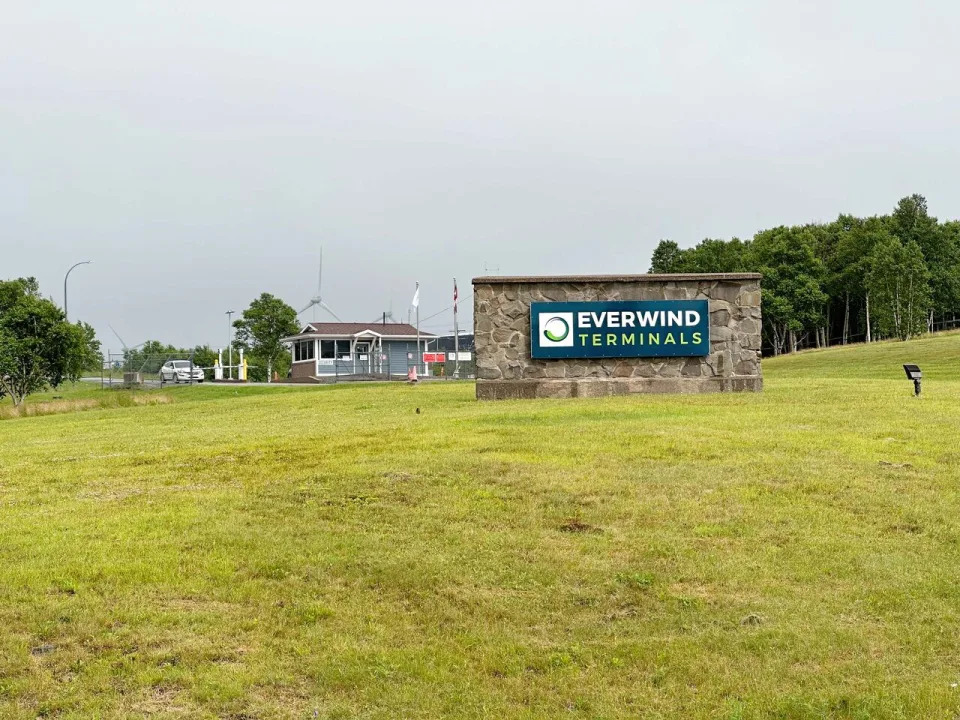
EverWind Fuels in Point Tupper, N.S., is getting a $125-milion loan from the federal government to help the company build a proposed green hydrogen production plant. (Tom Ayers/CBC - image credit)
The federal Liberal government is making a $125-million loan to a proposed green hydrogen facility in Nova Scotia's Strait of Canso area.
The proponent, EverWind Fuels, says the funding makes the project closer to reality than any other of its kind in the Western hemisphere.
More than 50 municipal and business officials from around Cape Breton and the mainland near the Strait crowded into the Port Hawkesbury civic centre late Friday afternoon.
There were cheers as Sean Fraser, Liberal MP for Central Nova, announced the funding.
He and EverWind CEO Trent Vichie said the project is expected to bring thousands of jobs to Cape Breton and Nova Scotia.
"Hopefully, it can mean that the region is a leader in the world and hopefully it brings some folks who've been working out west back home," Vichie said.
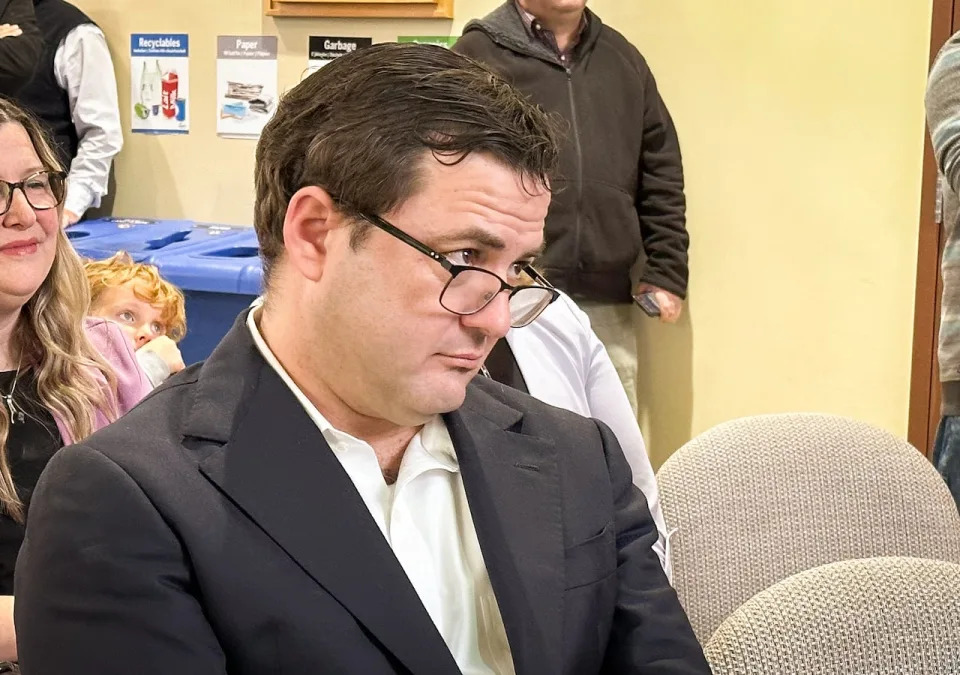
EverWind CEO Trent Vichie says the company plans to use solar power at its proposed plant and wind power from Colchester County to extract hydrogen from water. (Tom Ayers/CBC)
Vichie said the company has invested $200 million already and the federal loan will help further the design of a hydrogen production facility in Richmond County's Point Tupper Industrial Park.
That's where the company bought a petrochemical storage plant with access to rail and pipelines to a ship-loading facility in the Strait.
Vichie said some site preparation work has already begun at the facility in Point Tupper.
The plan is to use wind and solar energy sources to extract hydrogen from the water in nearby Landrie Lake and to convert the hydrogen to energy for export.
EverWind's large wind turbine projects in Colchester County are going through the regulatory process and, along with solar panels at the planned production facility, the $3-billion project will produce cheap green hydrogen fuel, Vichie said.
Fraser said clean energy will then be available for export to other countries, including Germany, which has already signed agreements with Canada.
He said talks are also underway for the development of storage and distribution systems for green energy use in Nova Scotia, but Vichie said that would constitute a second phase of the development.
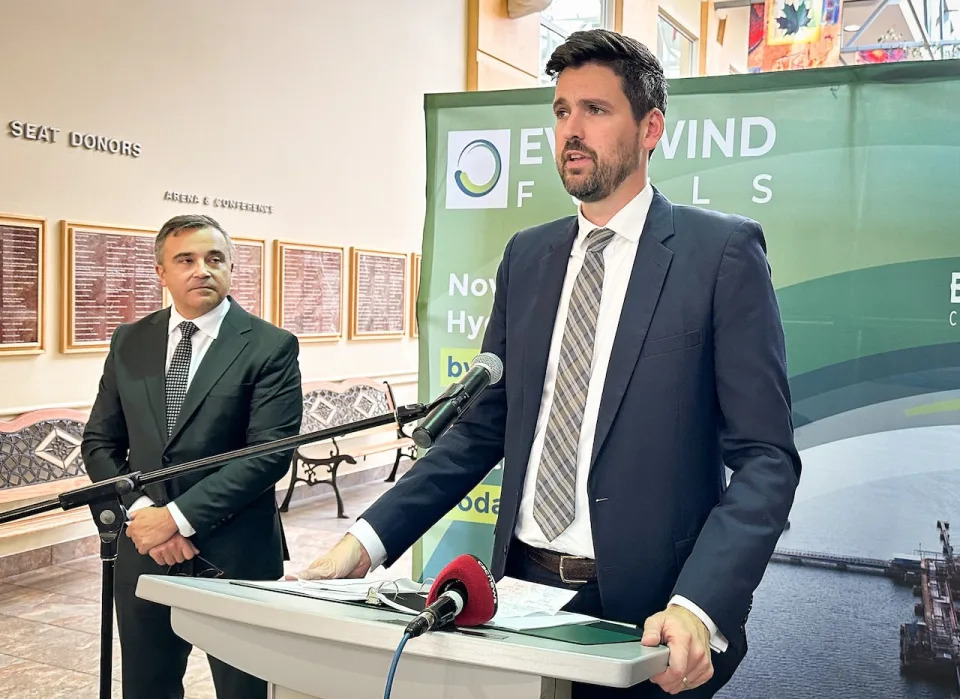
Liberal Housing Minister Sean Fraser says there is another green hydrogen project nearby at Bear Head, but EverWind's project is farther along in planning and development. (Tom Ayers/CBC)
Another green hydrogen project is being proposed not far away in Point Tupper at the Bear Head site.
Fraser said the federal government would consider investing in that project as well, but EverWind is leading the pack in terms of readiness.
"This is actually the most advanced green hydrogen project in the Western hemisphere," the MP and federal housing minister said.
"There is not another one on this side of the planet, let alone this side of the Strait of Canso, that compares."
Power grid investment
Vichie said EverWind plans to use solar panels at its production plant and is working with governments and Nova Scotia Power to bring electricity from its proposed wind farms in Colchester County, about 200 kilometres away, to the Point Tupper site.
He said that will require the company to invest in the province's power grid, but it will also add more renewable sources to the system as it transitions away from fossil fuels.
"It's part of the cost of doing business, but I think it works as a win-win for both," Vichie said.
Fraser said it will make the green energy more costly, but it would still make economic sense.
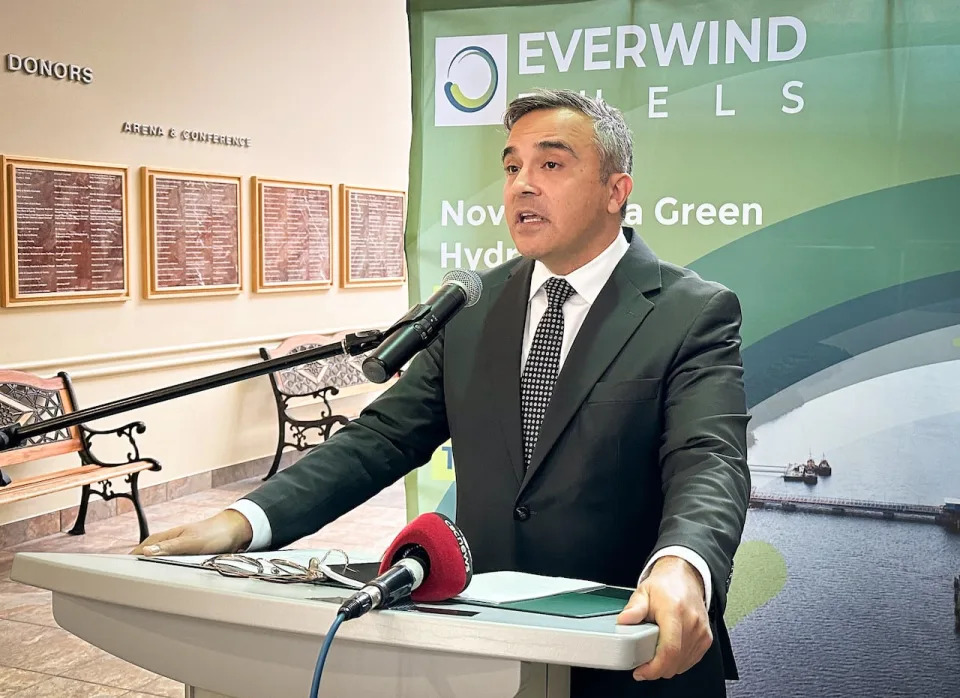
Cape Breton-Canso Liberal MP Mike Kelloway says the federal loan for EverWind is a vote of confidence in Cape Breton and in Nova Scotia. (Tom Ayers/CBC)
"When you're dealing with a multi-billion-dollar private sector investment, the cost of transmission is going to be a small component compared to the extraordinary magnitude of an investment of this nature," he said.
"In Nova Scotia, it's going to put thousands of people to work."
Vichie said there's plenty of investment capital available for green energy production, but there aren't enough plants in operation.
The real problem is that green hydrogen is an emerging technology and government regulations have not yet caught up to the demand, he said.
"We have three investment banks working with us," Vichie said. "That is the least of my worries. It's more just getting through the development permits ready to build."
EverWind expects to make a final investment decision early in the new year, but is already spending money on the assumption the project will go ahead, he said.
CBC
Fri, November 17, 2023

EverWind Fuels in Point Tupper, N.S., is getting a $125-milion loan from the federal government to help the company build a proposed green hydrogen production plant. (Tom Ayers/CBC - image credit)
The federal Liberal government is making a $125-million loan to a proposed green hydrogen facility in Nova Scotia's Strait of Canso area.
The proponent, EverWind Fuels, says the funding makes the project closer to reality than any other of its kind in the Western hemisphere.
More than 50 municipal and business officials from around Cape Breton and the mainland near the Strait crowded into the Port Hawkesbury civic centre late Friday afternoon.
There were cheers as Sean Fraser, Liberal MP for Central Nova, announced the funding.
He and EverWind CEO Trent Vichie said the project is expected to bring thousands of jobs to Cape Breton and Nova Scotia.
"Hopefully, it can mean that the region is a leader in the world and hopefully it brings some folks who've been working out west back home," Vichie said.

EverWind CEO Trent Vichie says the company plans to use solar power at its proposed plant and wind power from Colchester County to extract hydrogen from water. (Tom Ayers/CBC)
Vichie said the company has invested $200 million already and the federal loan will help further the design of a hydrogen production facility in Richmond County's Point Tupper Industrial Park.
That's where the company bought a petrochemical storage plant with access to rail and pipelines to a ship-loading facility in the Strait.
Vichie said some site preparation work has already begun at the facility in Point Tupper.
The plan is to use wind and solar energy sources to extract hydrogen from the water in nearby Landrie Lake and to convert the hydrogen to energy for export.
EverWind's large wind turbine projects in Colchester County are going through the regulatory process and, along with solar panels at the planned production facility, the $3-billion project will produce cheap green hydrogen fuel, Vichie said.
Fraser said clean energy will then be available for export to other countries, including Germany, which has already signed agreements with Canada.
He said talks are also underway for the development of storage and distribution systems for green energy use in Nova Scotia, but Vichie said that would constitute a second phase of the development.

Liberal Housing Minister Sean Fraser says there is another green hydrogen project nearby at Bear Head, but EverWind's project is farther along in planning and development. (Tom Ayers/CBC)
Another green hydrogen project is being proposed not far away in Point Tupper at the Bear Head site.
Fraser said the federal government would consider investing in that project as well, but EverWind is leading the pack in terms of readiness.
"This is actually the most advanced green hydrogen project in the Western hemisphere," the MP and federal housing minister said.
"There is not another one on this side of the planet, let alone this side of the Strait of Canso, that compares."
Power grid investment
Vichie said EverWind plans to use solar panels at its production plant and is working with governments and Nova Scotia Power to bring electricity from its proposed wind farms in Colchester County, about 200 kilometres away, to the Point Tupper site.
He said that will require the company to invest in the province's power grid, but it will also add more renewable sources to the system as it transitions away from fossil fuels.
"It's part of the cost of doing business, but I think it works as a win-win for both," Vichie said.
Fraser said it will make the green energy more costly, but it would still make economic sense.

Cape Breton-Canso Liberal MP Mike Kelloway says the federal loan for EverWind is a vote of confidence in Cape Breton and in Nova Scotia. (Tom Ayers/CBC)
"When you're dealing with a multi-billion-dollar private sector investment, the cost of transmission is going to be a small component compared to the extraordinary magnitude of an investment of this nature," he said.
"In Nova Scotia, it's going to put thousands of people to work."
Vichie said there's plenty of investment capital available for green energy production, but there aren't enough plants in operation.
The real problem is that green hydrogen is an emerging technology and government regulations have not yet caught up to the demand, he said.
"We have three investment banks working with us," Vichie said. "That is the least of my worries. It's more just getting through the development permits ready to build."
EverWind expects to make a final investment decision early in the new year, but is already spending money on the assumption the project will go ahead, he said.
SaskPower, Ontario Power Generation sign deal to co-ordinate on small modular nuclear reactors
EXPERIMENTAL NOT COMMERCIAL YET
CBC
Mon, November 20, 2023

Ontario Minister of Energy Todd Smith and Saskatchewan Minister in charge of SaskPower Dustin Duncan helped announce an agreement between the province's Crown corporations to push forward the development of small modular reactor technology. (Alexander Quon/CBC - image credit)
Saskatchewan and Ontario say they've taken another step toward implementing small modular reactor (SMR) technology in both provinces.
Dustin Duncan, Saskatchewan's minister responsible for SaskPower, was joined by Ontario Energy Minister Todd Smith Monday morning as SaskPower announced it had signed a master services agreement with Ontario Power Generation and its subsidiary Laurentis Energy Partners.
The five-year deal between the two Crown corporations will allow them to co-ordinate the development of a Canadian fleet of small modular nuclear reactors, Duncan said.
"To have an agreement that allows us to tap into that expertise and knowledge from a jurisdiction and organizations that have a great deal of expertise and history in the nuclear sector is critically important for Saskatchewan to carry forward with," he said.
Ontario is currently building the first of four SMRs at its nuclear facility in Darlington.
SaskPower has identified Estevan, located in the province's southeast, and Elbow, located about midway between Saskatoon and Regina, as two sites that could potentially host SMRs.
A final decision on the location to build one SMR is not expected until late 2024, SaskPower CEO Rupen Pandya told media.
"We've had ongoing consultations with communities and members in those communities regarding those sites," Pandya said.

An artist's rendering of the SMR technology proposed for Ontario's Darlington location. Saskatchewan plans on exploring the same type of reactor.
An artist's rendering of the SMR technology proposed for Ontario's Darlington location. Saskatchewan plans on exploring the same type of reactor. (Ontario Power Generation)
What is an SMR?
SMRs generate nuclear power. The idea is to help fuel the transition to net-zero emissions and meet the federal government's climate goals.
Saskatchewan and three other provinces — Ontario, New Brunswick and Alberta — have led the charge on developing SMR technology to help supply power in their respective provinces.
Like their name implies, SMRs are much smaller than traditional nuclear reactors.
While a conventional nuclear reactor generates about 1,000 megawatts of energy, SMRs generate between 200 and 300 megawatts — enough to power about 300,000 homes.
A final decision on whether to build a SMR in Saskatchewan is not expected until 2029.
The GE-Hitachi BWRX-300 is the type of reactor identified for development in Saskatchewan. It's the same model chosen by Ontario Power Generation.
If approved, construction could begin as early as 2030, with the first SMR coming on line sometime in 2034. Additional facilities could follow.
EXPERIMENTAL NOT COMMERCIAL YET
CBC
Mon, November 20, 2023

Ontario Minister of Energy Todd Smith and Saskatchewan Minister in charge of SaskPower Dustin Duncan helped announce an agreement between the province's Crown corporations to push forward the development of small modular reactor technology. (Alexander Quon/CBC - image credit)
Saskatchewan and Ontario say they've taken another step toward implementing small modular reactor (SMR) technology in both provinces.
Dustin Duncan, Saskatchewan's minister responsible for SaskPower, was joined by Ontario Energy Minister Todd Smith Monday morning as SaskPower announced it had signed a master services agreement with Ontario Power Generation and its subsidiary Laurentis Energy Partners.
The five-year deal between the two Crown corporations will allow them to co-ordinate the development of a Canadian fleet of small modular nuclear reactors, Duncan said.
"To have an agreement that allows us to tap into that expertise and knowledge from a jurisdiction and organizations that have a great deal of expertise and history in the nuclear sector is critically important for Saskatchewan to carry forward with," he said.
Ontario is currently building the first of four SMRs at its nuclear facility in Darlington.
SaskPower has identified Estevan, located in the province's southeast, and Elbow, located about midway between Saskatoon and Regina, as two sites that could potentially host SMRs.
A final decision on the location to build one SMR is not expected until late 2024, SaskPower CEO Rupen Pandya told media.
"We've had ongoing consultations with communities and members in those communities regarding those sites," Pandya said.

An artist's rendering of the SMR technology proposed for Ontario's Darlington location. Saskatchewan plans on exploring the same type of reactor.
An artist's rendering of the SMR technology proposed for Ontario's Darlington location. Saskatchewan plans on exploring the same type of reactor. (Ontario Power Generation)
What is an SMR?
SMRs generate nuclear power. The idea is to help fuel the transition to net-zero emissions and meet the federal government's climate goals.
Saskatchewan and three other provinces — Ontario, New Brunswick and Alberta — have led the charge on developing SMR technology to help supply power in their respective provinces.
Like their name implies, SMRs are much smaller than traditional nuclear reactors.
While a conventional nuclear reactor generates about 1,000 megawatts of energy, SMRs generate between 200 and 300 megawatts — enough to power about 300,000 homes.
A final decision on whether to build a SMR in Saskatchewan is not expected until 2029.
The GE-Hitachi BWRX-300 is the type of reactor identified for development in Saskatchewan. It's the same model chosen by Ontario Power Generation.
If approved, construction could begin as early as 2030, with the first SMR coming on line sometime in 2034. Additional facilities could follow.
Subscribe to:
Posts (Atom)
